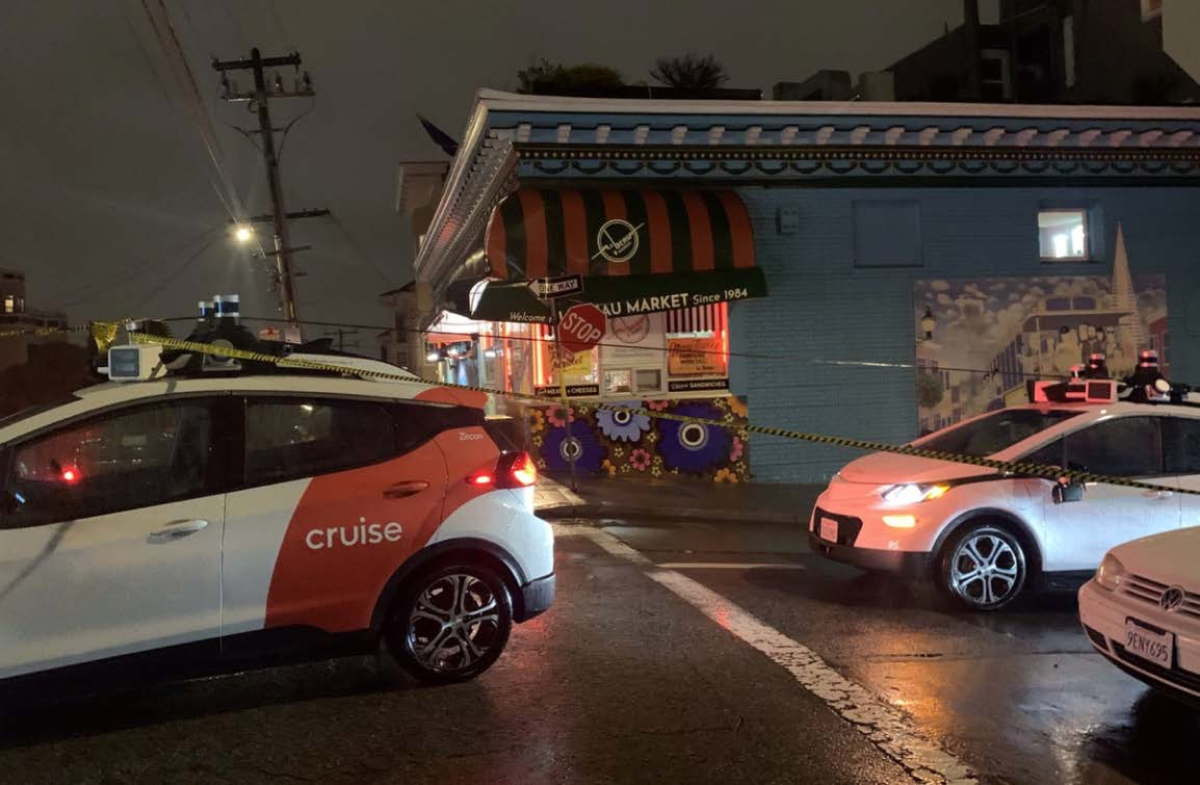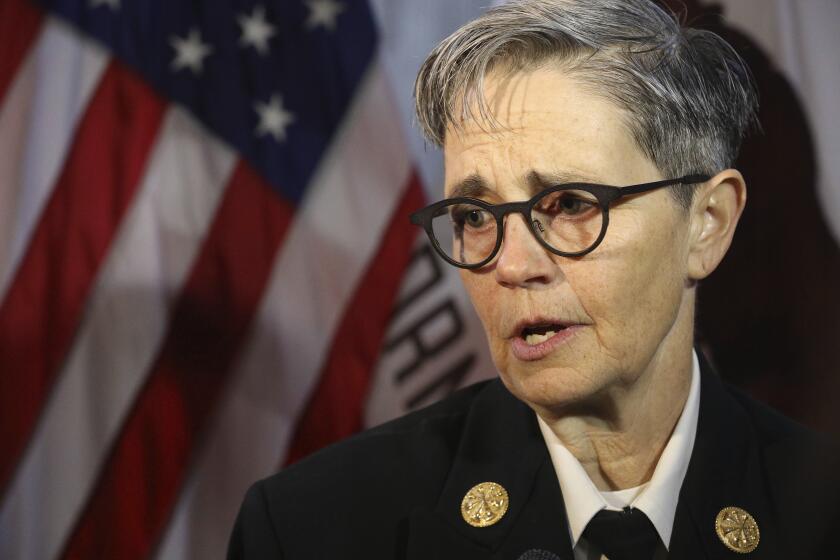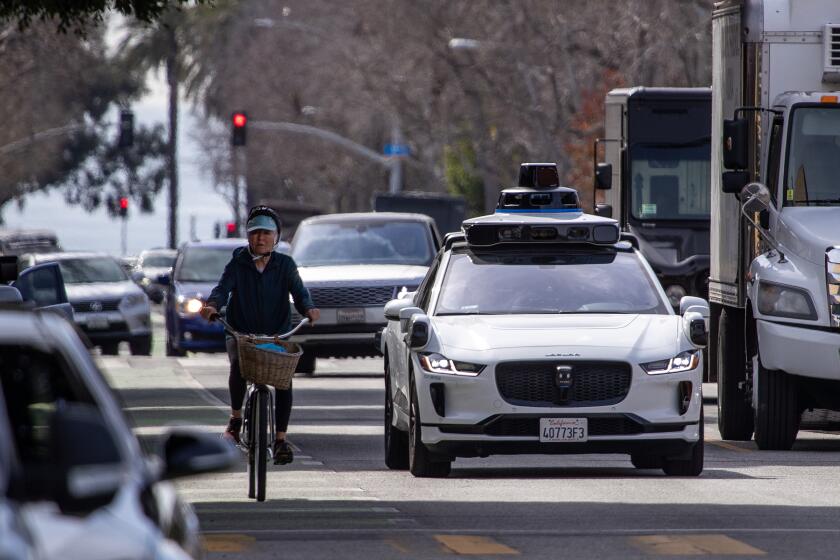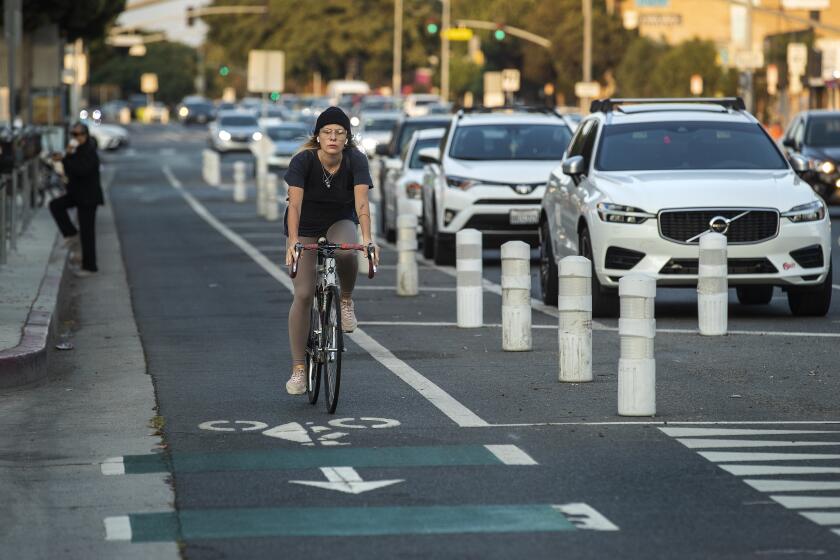San Francisco police back the fire chief’s complaint about robotaxis interfering with first responders

- Share via
San Francisco is in an uproar over robotaxis’ persistent interference with firefighters, police officers and other emergency medical personnel.
The city’s fire chief called attention Thursday to the potentially dangerous encounters between driverless cabs and first responders, telling The Times in an interview that she was “fed up” with the incidents, which include robotaxis driving into active emergency scenes and parking on a fire hose.
Now San Francisco’s police union has joined city officials in urging regulators to postpone a vote, scheduled for Thursday, on a measure that would allow Waymo, Cruise and other robotaxi companies to expand in San Francisco. (After this story published, the vote was pushed to July 13.)
The San Francisco Police Officers Assn. has delivered a letter to the California Public Utilities Commission, which regulates driverless car operations in the state, asking that it “reconsider the agenda items” at its upcoming meeting and postpone a vote until the issue is addressed.
“While we all applaud the advancements in technology, we must not be in such a rush that we forget the human element and [that] ... such technology unchecked can create dangerous situations,” union President Tracy McCray said.
As robotaxi companies plan to provide service in Los Angeles, San Francisco officials battle with state regulators over robotaxi safety.
The commission has not responded to multiple requests for comment.
Waymo spokesperson Katherine Barna said in a statement: “As we operate in some of the densest parts of San Francisco and Phoenix, we navigate and interact with active emergency vehicles day and night, smoothly. In fact, we encounter an active [emergency vehicle] every 100 miles in our [more than 2 million] miles of rider-only driving.
“The vast majority of these often challenging and complex encounters have been without issue.”
Barna also noted that the company provides training to emergency personnel “and provides a phone number to reach Waymo directly in the event of a stop.”
Hannah Lindow, spokesperson for Cruise, sent a statement as well.
“Improving road safety is our chief mission — not only for Cruise passengers but for everyone we share the road with,” she said. “That includes making sure our vehicles are operating with as minimal impact as possible to city services. We’ve long met regularly with San Francisco city officials and first responders, and look forward to continuing our open line of communication with them.”
Lindow also said that Cruise has driven more than 2 million miles without life-threatening injuries or deaths, and that policymakers should also consider the “deeply troubling status quo” of injuries and road deaths in San Francisco.
Both companies have been running small-scale passenger services in San Francisco.
For the record:
12:21 p.m. June 24, 2023An earlier version of this story said Waymo charges for rides while Cruise does not. Cruise charges for rides, while Waymo doesn’t yet but is seeking to do so.
Cruise, which requires passengers to apply for the program, charges for rides. Waymo doesn’t yet charge but is seeking a green light to do so at next week’s Public Utilities Commission meeting.
If the proposal is approved, it would also allow an unlimited number of Waymo and Cruise robotaxis to operate and collect fares in all parts of the city in any kind of weather.
Waymo and robotaxi company Motional are planning to begin driverless passenger service in Los Angeles and Santa Monica when they get permits from the Public Utilities Commission. In written comments to the commission, the transportation departments of both cities have expressed concerns about how driverless technology is being managed by state regulators.
The San Francisco Fire Department has reported at least 39 interference incidents so far this year, including robotaxis stopping in front of firehouse driveways, blocking emergency vehicles trying to respond to emergencies, driving through police tape, driving into downed electrical wires that then became tangled on their rooftop sensors, pulling into active fire scenes and stopping (in one instance, a fire hose got caught around the car’s axle), and stopping close enough behind a firetruck to interfere with the unloading of ladders at a fire scene.
When delivery trucks and other vehicles double-park or otherwise block the road, in most cases the driver is in the vehicle or nearby. But when a Waymo or Cruise car is stuck in the road, firefighters must try to communicate with the operating company over a radio.
Sometimes a remote operator is able to move the vehicle. Sometimes the Fire Department must wait for a human employee to arrive and move the car.
There have been no reported deaths or injuries as a result, but Jeanine Nicholson, San Francisco’s fire chief, told ABC7 News Bay Area on Thursday, after The Times broke the story, that “the biggest concern is that someone is going to get really severely injured or killed.”
“We’ve really gotten lucky so far,” the chief said. “But it’s only a matter of time before something really, really catastrophic happens.”
Historian Peter Norton isn’t confident cars will fix the problems cars caused.
No one involved in the debate disputes the idea that automated vehicles hold great promise for safety and accessibility. Nicholson told The Times she believes robotaxi AI needs to get a lot better at dealing with emergency scenes before any fleet expansion.
Why these high-tech vehicles, with their sensors and artificial intelligence programming, have problems with emergency vehicles is unclear. The National Highway Traffic Safety Administration launched an investigation into Tesla after that company’s driver-assist software apparently led to multiple collisions with parked police cars, ambulances and firetrucks.
Public data on autonomous vehicle safety issues are hard to come by. NHTSA requires serious collisions to be reported to the agency, although it shields most of the narrative description of crashes from the public.
The California Department of Motor Vehicles requires that robotaxi companies report collisions of any type. But in 2021, the DMV asked Waymo to sue the agency, then the two worked out a court-approved deal that allows robotaxi companies to claim trade secrets to keep safety information from the public.
The DMV appears to interpret that settlement broadly. As a result of the agreement, even facts about how a robotaxi company responds in emergencies can be blacked out on ostensibly public crash reports.
On Thursday, more than two years after the Public Utilities Commission approved passenger fare service by driverless vehicles, the agency held what it says will be a series of workshops on what driverless data should be collected and how much of it should be made available to the public.
Two of the five commissioners, Genevieve Shiroma and John Reynolds, presided at the workshop. Shiroma previously served in state government roles; Reynolds most recently served as the top attorney at Cruise.
More to Read
Inside the business of entertainment
The Wide Shot brings you news, analysis and insights on everything from streaming wars to production — and what it all means for the future.
You may occasionally receive promotional content from the Los Angeles Times.












